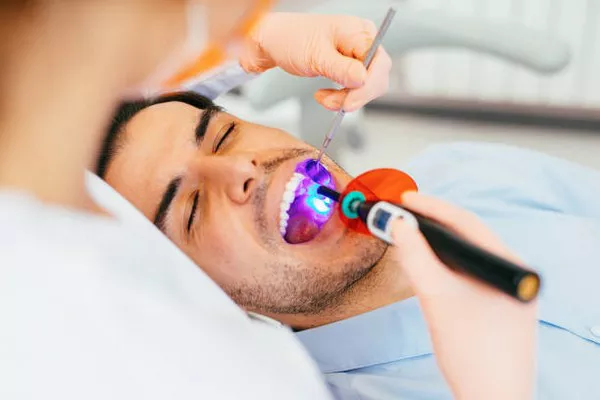Whitening strips are a popular over-the-counter product designed to lighten the color of teeth by removing surface stains and, to some extent, deeper stains. These thin, flexible strips are coated with a peroxide-based gel and are applied directly to the teeth. They are typically used for a specified period, usually ranging from 10 minutes to an hour, depending on the product and the concentration of the active ingredients. Whitening strips offer a convenient and relatively affordable option for achieving a brighter smile at home without the need for professional dental visits.
Active Ingredients
The primary active ingredients in most whitening strips are hydrogen peroxide or carbamide peroxide. These compounds act as bleaching agents that break down stains on the enamel surface through an oxidation process.
Hydrogen Peroxide
Hydrogen peroxide is the most common bleaching agent used in whitening strips. It is a potent oxidizing agent that breaks down into water and oxygen radicals, which interact with the chromogens (colored molecules) on the teeth. This reaction helps to lift and dissolve the stains, resulting in whiter teeth. Hydrogen peroxide concentrations in whitening strips typically range from 3% to 10%.
Carbamide Peroxide
Carbamide peroxide is another bleaching agent used in some whitening strips. It is a compound of hydrogen peroxide and urea and breaks down into hydrogen peroxide when applied to the teeth. It acts more slowly than hydrogen peroxide but is equally effective in whitening teeth. Carbamide peroxide concentrations in whitening strips usually range from 10% to 20%.
Both hydrogen peroxide and carbamide peroxide are effective at whitening teeth, but they must be used correctly to minimize potential risks and side effects.
Potential Risks
While whitening strips are generally safe for most users, there are potential risks associated with their use, particularly if used incorrectly or excessively.
Enamel Damage
One of the primary concerns with the use of whitening strips is the potential for enamel damage. Enamel is the hard, protective outer layer of the teeth, and excessive or prolonged exposure to bleaching agents can weaken it. This damage can lead to increased susceptibility to cavities and other dental issues. Studies have shown that high concentrations of hydrogen peroxide can cause microstructural changes in the enamel, such as increased porosity and surface roughness.
Dentin Sensitivity
Another common side effect of using whitening strips is dentin sensitivity. Dentin is the layer beneath the enamel that contains microscopic tubules leading to the nerve endings of the teeth. When the enamel is compromised, these tubules can become exposed, leading to sensitivity. Users may experience sharp, transient pain when consuming hot, cold, or sweet foods and beverages. This sensitivity is usually temporary but can be quite uncomfortable.
Gum Irritation
Improper application of whitening strips can also cause gum irritation. If the strips come into contact with the soft tissues of the gums, the bleaching agents can cause irritation, redness, and even chemical burns. It is essential to apply the strips carefully and avoid contact with the gums to minimize this risk.
Effectiveness
Whitening strips can be highly effective at removing surface stains caused by factors such as coffee, tea, red wine, and tobacco use. These stains are extrinsic, meaning they are on the outer layer of the teeth and are more easily removed by bleaching agents.
Surface Stains
Surface stains are typically caused by the consumption of dark-colored foods and beverages, smoking, and poor oral hygiene. Whitening strips can effectively break down and lift these stains, resulting in noticeably whiter teeth. Most users see significant improvements within a few days to a couple of weeks of regular use.
Intrinsic Stains
Intrinsic stains, on the other hand, are deeper stains within the tooth structure. These can be caused by factors such as aging, certain medications, excessive fluoride exposure, and trauma to the teeth. Whitening strips are less effective at treating intrinsic stains because the bleaching agents cannot penetrate deeply enough into the tooth structure to remove them. For intrinsic stains, professional treatments such as in-office bleaching or veneers may be necessary.
Usage Guidelines
To achieve the best results and minimize the risks associated with whitening strips, it is important to follow the usage guidelines provided by the manufacturer and dental professionals.
see also:What Is The Best Whitening For Your Teeth
Recommended Duration and Frequency
Most whitening strips are designed to be used once daily for a period of 10 to 60 minutes, depending on the product. It is crucial not to exceed the recommended duration to prevent enamel damage and gum irritation. The typical treatment course lasts from 7 to 14 days. Users should avoid using whitening strips more frequently than recommended, as overuse can increase the risk of adverse effects.
Best Practices
Apply Carefully: Ensure the strips are applied evenly and avoid contact with the gums.
Follow Instructions: Adhere strictly to the instructions provided with the product regarding application time and frequency.
Monitor Sensitivity: If you experience increased sensitivity or discomfort, reduce the frequency of use or discontinue use temporarily.
Maintain Oral Hygiene: Continue with regular brushing and flossing to maintain oral health and maximize the effectiveness of the whitening treatment.
Avoid Stain-Causing Substances: During and after the whitening treatment, minimize the consumption of stain-causing foods and beverages to prolong the results.
Alternatives to Whitening Strips
For individuals seeking alternatives to whitening strips, several other methods can be considered, ranging from professional dental treatments to other over-the-counter products.
Professional Dental Treatments
In-Office Whitening: Performed by a dentist, in-office whitening involves applying a high-concentration bleaching gel to the teeth and using a special light to accelerate the whitening process. This method offers immediate and more dramatic results compared to over-the-counter products.
Take-Home Kits: Dentists can provide custom-made trays and professional-grade whitening gel for use at home. These kits are more effective than store-bought whitening strips and allow for more control over the bleaching process.
Over-the-Counter Products
Whitening Toothpaste: These toothpastes contain mild abrasives and low concentrations of peroxide to help remove surface stains. They are less effective than whitening strips but can be used for maintenance.
Whitening Pens: These pens contain a bleaching gel that can be applied directly to the teeth. They are convenient for touch-ups and small areas of staining but may not provide uniform results.
Whitening Rinses: Mouth rinses with whitening agents can help reduce surface stains over time. They are easy to use but generally less effective than strips or professional treatments.
see also:Why is my teeth still yellow after brushing?
Dental Consultation
Before beginning any whitening treatment, it is important to consult with a dentist, especially for individuals with pre-existing dental conditions. A dental professional can assess the suitability of whitening strips for your specific needs and provide guidance on safe usage.
Pre-Existing Conditions
Tooth Decay: Whitening agents can exacerbate sensitivity and irritation in decayed teeth.
Gum Disease: Inflamed gums are more susceptible to irritation from bleaching agents.
Restorations: Fillings, crowns, and veneers do not respond to bleaching agents, which can result in uneven coloring.
A dental consultation ensures that any underlying dental issues are addressed before starting a whitening regimen, thereby reducing the risk of complications.
Pros and Cons
To help users make an informed decision, it is important to weigh the advantages and disadvantages of using whitening strips.
Advantages
Convenience: Whitening strips are easy to use and can be applied at home without the need for professional assistance.
Affordability: They are generally more affordable than professional whitening treatments.
Effectiveness: Whitening strips can provide noticeable results in a relatively short period, especially for surface stains.
Disadvantages
Potential Risks: There is a risk of enamel damage, dentin sensitivity, and gum irritation if not used correctly.
Limited Efficacy: Whitening strips are less effective on intrinsic stains and cannot change the color of dental restorations.
Temporary Results: The results from whitening strips are not permanent and may require maintenance treatments.
Conclusion
Whitening strips offer a convenient and effective way to achieve a brighter smile at home. However, their use comes with potential risks, such as enamel damage and dentin sensitivity, particularly when used improperly or excessively. While they are highly effective at removing surface stains, their ability to treat intrinsic stains is limited. Following recommended usage guidelines, consulting with a dentist, and considering alternative whitening methods can help ensure safe and satisfactory results. Ultimately, whitening strips can be a valuable tool for many individuals seeking a whiter smile, but they should be used with caution and under the guidance of a dental professional.
FAQs about Whitening Strips
1. Will Whitening Strips Damage Fake Teeth?
Whitening strips are designed to lighten natural tooth enamel and do not affect the color of dental restorations like crowns, veneers, or fillings. However, while they won’t damage these fake teeth, the difference in color between natural teeth and restorations can become more noticeable after using whitening strips. Consult your dentist before using whitening products if you have dental restorations to ensure a uniform appearance.
2. What is the Downside of White Strips?
While whitening strips can effectively brighten your smile, there are some potential downsides:
Tooth Sensitivity: Whitening agents can penetrate the enamel and irritate the nerves, leading to increased sensitivity, especially with prolonged use.
Gum Irritation: The chemicals in the strips can irritate the gums if they come into contact with the soft tissue.
Uneven Whitening: Strips may not cover all areas of the teeth evenly, leading to inconsistent whitening results.
Temporary Results: The whitening effects are not permanent and typically last a few months to a year, depending on diet and oral hygiene habits.
3. Why Are Whitening Strips Banned?
Whitening strips are generally safe and widely available, but they may be banned or restricted in some countries due to their active ingredients, typically hydrogen peroxide or carbamide peroxide. In higher concentrations, these chemicals can pose risks such as tooth sensitivity, gum irritation, and damage to enamel if misused. Regulations aim to ensure consumer safety by limiting the concentration of whitening agents and controlling how these products are marketed and used.
4. Are Whitening Strips Safe to Use Daily?
Most whitening strips are not intended for daily use. Overuse can lead to significant tooth sensitivity and enamel erosion. It’s important to follow the manufacturer’s instructions, which typically recommend using the strips once a day for a specific period, such as 7 to 14 days. For ongoing maintenance, occasional use is usually sufficient. If you’re considering frequent use, consult your dentist to avoid potential damage to your teeth and gums.
You Might Be Interested In






























